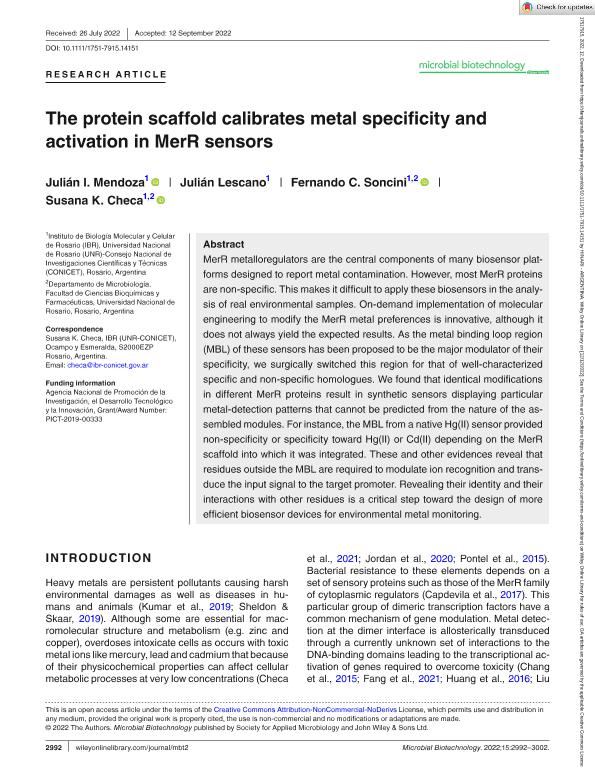Artículo
The protein scaffold calibrates metal specificity and activation in MerR sensors
Mendoza Fernández, Julián Ignacio ; Lescano, Julian
; Lescano, Julian ; Soncini, Fernando Carlos
; Soncini, Fernando Carlos ; Checa, Susana Karina
; Checa, Susana Karina
 ; Lescano, Julian
; Lescano, Julian ; Soncini, Fernando Carlos
; Soncini, Fernando Carlos ; Checa, Susana Karina
; Checa, Susana Karina
Fecha de publicación:
09/2022
Editorial:
John Wiley & Sons Ltd
Revista:
Microbial Biotechnology
ISSN:
1751-7915
Idioma:
Inglés
Tipo de recurso:
Artículo publicado
Clasificación temática:
Resumen
MerR metalloregulators are the central components of many biosensor platforms designed to report metal contamination. However, most MerR proteins are non-specific. This makes it difficult to apply these biosensors in the analysis of real environmental samples. On-demand implementation of molecular engineering to modify the MerR metal preferences is innovative, although it does not always yield the expected results. As the metal binding loop region (MBL) of these sensors has been proposed to be the major modulator of their specificity, we surgically switched this region for that of well-characterized specific and non-specific homologues. We found that identical modifications in different MerR proteins result in synthetic sensors displaying particular metal-detection patterns that cannot be predicted from the nature of the assembled modules. For instance, the MBL from a native Hg(II) sensor provided non-specificity or specificity toward Hg(II) or Cd(II) depending on the MerR scaffold into which it was integrated. These and other evidences reveal that residues outside the MBL are required to modulate ion recognition and transduce the input signal to the target promoter. Revealing their identity and their interactions with other residues is a critical step toward the design of more efficient biosensor devices for environmental metal monitoring.
Archivos asociados
Licencia
Identificadores
Colecciones
Articulos(IBR)
Articulos de INST.DE BIOLOGIA MOLECULAR Y CELULAR DE ROSARIO
Articulos de INST.DE BIOLOGIA MOLECULAR Y CELULAR DE ROSARIO
Citación
Mendoza Fernández, Julián Ignacio; Lescano, Julian; Soncini, Fernando Carlos; Checa, Susana Karina; The protein scaffold calibrates metal specificity and activation in MerR sensors; John Wiley & Sons Ltd; Microbial Biotechnology; 15; 12; 9-2022; 2992-3002
Compartir
Altmétricas



